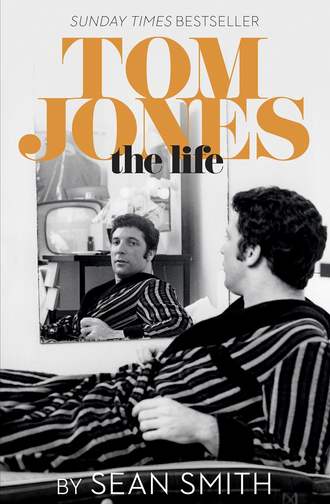
Полная версия
Tom Jones - The Life
2
The Prisoner of Laura Street
Tom didn’t enjoy going to school. He was a poor student and, like most of his pals, couldn’t wait for the time to pass so he could leave and become a man. In later years, he was able to attribute his slow academic progress to dyslexia, but that diagnosis wasn’t readily available in the 1940s, and Tom was perceived variously as being disinterested or not very bright. Even the basics of reading, writing and arithmetic failed to inspire him.
He began in the local infants school before moving on to Treforest Primary School in Wood Road and then to the Central Secondary Modern School at the top of Stow Hill. He wasn’t much interested in playing football or rugby, like his friend Dai Perry, but he did enjoy watching boxing. He liked drawing, but his principal interest was singing. Surprisingly, he showed little desire to join a choir. He knew he was the best singer in the school, but he wasn’t a team player and, from an early age, was very much a solo artist in the making.
That inclination extended to traditional carol singing at Christmas, when a group of his friends called for him at the house and asked if he would join them. He responded, ‘No, I don’t think I will tonight,’ and let them carry on, before slipping out to sing by himself. ‘If I was singing with four or five fellas, they drowned you out. They would always cock it up. You couldn’t shine. And I made more money singing by myself.’
His family obviously knew about his talent as a singer, but his friends didn’t realise he was gifted until they heard him sing at school one Friday afternoon. The teacher told the class to entertain themselves for a while during a free period. Tom started drumming his fingers hard upon the desk – he was beating out the sound of galloping horses. Then he began, ‘An old cowpoke went riding out one dark and windy day.’
The melancholy song ‘Riders in the Sky’ had been written in 1948 by Stan Jones, a friend of the multi-Oscar-winning director John Ford, the master of the Western genre. Jones composed songs for some of the most famous Westerns of all time, including The Searchers and Rio Grande, both starring John Wayne. The hugely evocative ‘Riders’, one of his earliest compositions, became his most famous, mainly because it was covered by a string of singers that included Bing Crosby, Johnny Cash, Peggy Lee and Frankie Laine.
The lyrics are based on an old folk tale about a cowboy told to change his ways or end up damned and forever chasing a thundering herd of cattle across the endless skies. Tommy Woodward was less concerned about the moral of the story and more interested in the famous chorus of the song, which was tailor-made for a young boy with a big voice who loved Westerns: ‘Yi-pi-yi-ay, Yi-pi-yi-oh, ghost riders in the sky’. It was his party piece and he never tired of singing it. Fortunately, his classmates didn’t get bored of his rendition, which became a weekly favourite. For many, their abiding memory of school was of Tom Jones singing that song.
His preferred version of the classic was by bandleader Vaughn Monroe, whose rich, resonant baritone vocal suited the ethereal nature of the song. Tommy could only imitate it by cupping his hands together, covering his mouth and pretending he was in a cave. Monroe’s recording was called ‘Riders in the Sky (A Cowboy Legend)’ and was the most successful of all, reaching number one in the Billboard charts in the US in 1949. If you listened to the radio, you couldn’t fail to hear it. Later versions added the word ‘Ghost’ at the beginning of the title, but Tom always remained loyal to the original. He acknowledged the significance of the song when he recorded it as the rousing opening track of his 1967 album Green, Green Grass of Home.
‘Riders in the Sky’ was important to Tom not just because it was a song he performed so much as a child, but because it told a story. He observed, ‘I love songs that paint a picture.’ Many of Tom’s best-loved songs, such as ‘Delilah’ and ‘Green, Green Grass of Home’, are hugely descriptive and evocative. He wasn’t a fan of repetitive pop chants like ‘She Loves You’.
One of Tom’s favourite stories is about the time he sang the Lord’s Prayer in class, performing it not as a solemn church song, but as a negro spiritual. His teacher was so amazed that he was asked to sing it again in front of the whole school. Schooldays weren’t filled with too many highlights for Tommy Woodward, but that was one of them.
Tom had recently celebrated his twelfth birthday when he started complaining to his mother that he was feeling tired. The normally lively boy had no energy. It was difficult enough at the best of times to get him up for school, but Freda couldn’t help noticing how listless her son had become. Sensibly, she decided that a trip to the doctor was called for. A precautionary X-ray revealed that Tom had a dark shadow on his lung: he had tuberculosis. The only good thing about such upsetting news was that the condition had been diagnosed early.
TB, or ‘The Black Spot’ as they grimly called it in the mining communities of South Wales, was a killer. The disease, which usually affects the lungs, is caught through the air by coming into contact with an infected person coughing or sneezing bacteria near you. Wales had one of the highest rates for TB in Europe – hardly surprising in close-knit communities where nearly every miner coped with a cough all his life.
The Woodwards were touched by the disease, as so many families were. His father’s side of the family experienced several instances of TB during Tom’s lifetime. His cousin Marie died from the disease at the age of twenty-one. Her sister Valerie was also stricken, but survived after spending two years in Sully Hospital, near Penarth, which specialised in tuberculosis cases and where the fresh sea air helped young lungs to heal.
The first decision that had to be made was whether to send Tom away to rest and recuperate and break up the family or accept the difficult challenge of nursing him back to health at home. Even if victims of the wretched disease survived, they faced the prospect of being crippled for life.
Freda decided she wanted to nurse her boy back to health at home. His condition was extremely serious, but he wasn’t a sickly child by nature and the disease had been identified at an early stage. As a result, the chances of him making a complete recovery were good. He was infectious for only a short time, while the treatments he received fought the bacteria. During that period, he needed to be kept isolated from his friends, so he wouldn’t cough and spread the infection. There was no magic cure, however. He needed absolute rest and a long period of convalescence to rebuild his strength, which wasn’t easy for an active boy.
His mother decided he should be moved down to the middle floor of the house, to a bigger room where the coal fireplace could keep him warm when the days became chilly. He needed to have the windows open at all times, lowered only slightly when a bitter wind whistled down Laura Street.
After the initial elation of not having to go to school, life became pretty boring. He explained, ‘Bed was a novelty at first. I didn’t have to go to school, which was great, since I wasn’t a good student. But being forbidden to sing during the first year was a real drag!’ In his boredom, he would drive his poor mother to distraction by frequently banging on the floor with a stick to attract her attention in the kitchen on the floor below. She would drop everything to rush and see what he needed.
Freda did her best to amuse her son. Sometimes she would sing and dance around the room to cheer him up. She urged him to draw with a set of Indian inks she bought for him. When he was allowed to have visitors, she encouraged friends and family to see him.
Cousin Margaret, who was ten at the time, recalls, ‘We realised it was serious. We were up there visiting him most of the time. Auntie Freda would say, “Come up and keep him company.” We would tell him about school and what we were doing. We were never bored with Tom.
‘But we could never play cards. My mother wouldn’t have us playing cards. Auntie Freda was the same. Cards were like the devil in the house. We were chapel – only a man could play cards, not a woman.’ Tom, perhaps as a result of his mother’s disapproval, has never had any inclination to play cards and has always shown a strong dislike of any form of gambling.
From his bed, Tom could look out of the window and see all the way down the valley. He recalled, ‘As good as that view was, I’d grow restless. So my parents would routinely move the bed around the room to change the scenery for me.’ Freda was forever cutting out pictures of cowboys from magazines and sticking them to the wall, so he would have something fresh to look at. Margaret observes, ‘It was lovely, his bedroom.’
The lifesaver for Tom was when his parents rented a heavy, dark-brown radio for him. It was the sort of old-fashioned wireless you could imagine listening to when the declaration of war was announced. Tom loved it. His parents didn’t mind if he listened to it late at night, when the BBC played American music into the small hours – time didn’t matter when you were in bed for twenty-four hours a day. Pirate radio and Radio 1 had yet to change the musical taste of a nation. In 1952, ‘Rock Around the Clock’ was still two years away. Instead, Tom grew to love the records of Mahalia Jackson, the ‘Queen of Gospel’, an influence he carried with him throughout his career. He also discovered the music of Big Bill Broonzy, the acclaimed master of the Chicago blues, whom Eric Clapton once called his role model and both Keith Richards and Ronnie Wood of The Rolling Stones identify as a key figure in the development of their guitar-playing.
This was music to stir the imagination of a twelve-year-old boy in Treforest. These wonderful performers helped shape his destiny and Tom never forgot the effect they had on him. He included Mahalia’s uplifting recording of the traditional American hymn ‘The Old Rugged Cross’ and Big Bill’s protest song ‘Black, Brown and White’ among his Desert Island Discs in a programme broadcast shortly after his seventieth birthday in 2010. Tom had heard the song ‘The Old Rugged Cross’ many times, because it was a favourite of Welsh choirs and was often sung at funerals and formal occasions. Tom had never heard it sung like this, however, and he was keen to try out the style.
After a year confined to his room, Tom had shown enough improvement to be allowed to get up for two hours a day. He still couldn’t go out, but was well enough to stand by the front door and wave to his friends as they walked up the hill to the quarry or the White Tips to play or gathered around the gas lamp-post as darkness fell to laugh and chat. Tom was frustrated and jealous. ‘I promised myself that when I could walk to that lamp-post, I’d never complain about anything again.’
Once he was stronger, Tom was allowed to resume singing. When he turned thirteen, his parents rented a black-and-white TV set in time to enjoy the coronation of Queen Elizabeth II. Tom was able to watch the performances of popular artists of the fifties, like the snappily dressed Frankie Vaughan. Ever since he’d first seen Al Jolson on screen, Tom was a magpie when it came to imitating other entertainers. He would absorb a hand gesture or a facial expression and file it away to use himself.
His parents also bought him a guitar, on which he could strum a few basic chords as rudimentary backing. Freda never forgot his delight when he saw the parcel wrapped up at the bottom of his bed: ‘There was happiness! To see Tom smile was all I wanted.’ Through the open window of his second-floor bedroom, he would serenade the neighbourhood. It was like a scene from the period drama Call the Midwife, as the mums in the street would pause their chores to listen to young Tommy Woodward sing.
Just imagine if The X Factor had existed back then. Tom’s would have been the ultimate sob story – young boy stricken with TB raises himself from his sickbed to ‘nail’ ‘Riders in the Sky’. There wouldn’t have been a dry eye on the judging panel.
Brian Blackler remembers visiting his friend, who was sitting up in bed singing ‘Riders in the Sky’ and other songs he had picked up from the radio, including ‘That Old Black Magic’. Artists from Marilyn Monroe to Frank Sinatra had recorded the song, but the version that had caught Tom’s ear was by Billy Daniels. Nobody sang the standard like the great black singer and Tom was struck by his unique phrasing. He decided he wanted to sing it that way too.
Eventually, after two long years, the fourteen-year-old Tom was considered well enough to venture into the outside world once more. Holidays during his childhood – as for most mining families – tended to consist of a day trip to Barry Island, but this time his parents thought he deserved a proper summer treat. Brian Blackler remembers the boys had borrowed bicycles and, as they were riding, Tom shouted over, ‘I’m going now to Porthcawl for a week. Do you fancy coming down?’ Brian, who was one of eight children and had never had a proper holiday either, jumped at the chance, and joined the Woodward family in a caravan by the seaside in the popular resort some thirty miles west of Cardiff. There wasn’t much to do other than muck about on the dunes or ‘freeze your balls off’ in the water – it was always cold in Porthcawl. Tom found a place to sing though: the back of an old lorry by the beach, where he could entertain other holidaymakers.
The holiday was a positive outcome at the end of his two-year sentence in Laura Street. The resumption of school wasn’t particularly welcome, however. A teacher had come in from time to time to help the patient with his lessons, but Tom’s heart had never been in it. For his age, Tom was well behind and hadn’t mastered the most basic elements of education. His handwriting and spelling were hopeless – not that he cared much. After all, he had met the girl who would be the love of his life.
3
A Teenager in Love
Being laid up in bed with tuberculosis isn’t an ideal situation for a lad struggling through adolescence. Tommy could only gaze out of his ‘prison’ window in frustration and watch the local schoolgirls laughing and gossiping in the street below. One in particular grabbed his attention – Melinda Trenchard was the prettiest girl in the neighbourhood.
Linda was the daughter of Bill and Vi Trenchard, who lived in Cliff Terrace, just a few hundred yards away from Laura Street across Wood Road. Her parents ran the County Cinema, near the railway station in Pontypridd, and were well known in the area. Vi was friendly with Tom’s mother, Freda, and, like her, was outgoing and popular.
As youngsters, Tom and Linda’s paths seldom crossed. Boys and girls played separately, unless they went to the same school. Linda, who is six months younger than Tom, went to a Catholic primary school, so he was only vaguely aware of who she was at that age. He noticed that she wore little crucifix earrings, like many of the local Catholic girls, but that was about all.
Tom first became aware of Linda properly, before he was struck down with TB, when she was playing marbles in the street with some friends. He recalled light-heartedly, ‘I must have been eleven. I walked down her street and she was bending down and playing marbles. I saw those great legs and all of a sudden I thought of her in a new light.’
He did pursue Linda, after a fashion, but it was more for a game of kiss chase than anything else. All the boys would chase the girls and if they were lucky enough to catch up with one, they had to give her a kiss. ‘My first proper kiss was with Linda and it was her first kiss too. Afterwards I had to run my wrists under cold water. I was an early starter.’ It was nothing more than a playground romance at this stage, although Tom has always been disarmingly frank and earthy about growing up: ‘I can remember the first time I got to know myself better – I thought I had broken it!’
When he was confined to his room, Linda was the girl he would watch out for most. He would quietly seethe when he saw her talking to the other boys, but he could do nothing about it. She never came to visit him, because, in those prim and proper days, girls who weren’t family didn’t visit boys in their homes. Linda, as Tom could see from his window, was maturing into a lovely teenager. Her old school friend Vimy Pitman observes, ‘She was very, very attractive. She was everybody’s cup of tea. She had a lovely figure and was the sweetest girl. She would never say anything nasty about anybody or get involved in arguments or anything. She really was a nice girl.’
When Tom emerged from Laura Street, he had changed. He was taller and broader and his hair had turned the colour of coal. Linda hadn’t seen him for two years. She recalled, ‘When we met up after he went back to school, I didn’t recognise him at first, but I was immediately attracted to him again.’
Tom was equally smitten. ‘I don’t know what the feeling was. All I knew was I had a feeling for this girl. She looked fantastic.’
It was a classic case of opposites attracting – good girl in the A stream meets a boy who couldn’t care less and was languishing in the Ds. Tom’s lack of interest in all things academic had become even more pronounced. He had fallen so far behind during his two years away from school that he saw little point in trying to catch up. Linda, on the other hand, was particularly accomplished at drawing and illustrating – an interest she might have had in common with Tom if he had stuck with it. Perhaps art was too closely associated with the boredom of TB, because music took over as soon as he was allowed to sing again.
The girls at school weren’t too bothered about Tom’s classroom credentials. Vimy acknowledges, ‘Lots of the girls, well, most of the girls, I suppose, found him very attractive. He seemed a bit rough to me, but he definitely had the charisma. He had a way with him – a swagger.’
Linda had no idea at first that he was a gifted singer. She hadn’t been present at any family sing-songs, nor had she heard him entertain classmates. Instead, she had to wait until his sister Sheila’s engagement party to hear him. She described it in a rare interview in the 1960s: ‘Tom’s mother and mine knew each other well, so it was quite natural that when his sister got engaged he should invite me to the party. It was there I first really heard him sing. He sang “Ghost Riders in the Sky” and accompanied himself by tapping his fingers on the table. I wish it had been recorded.’
The opportunities for teenage courtship in Treforest were few. Linda and Tom got together first of all at the local youth club. She recalled, ‘We were too young to say we were going together, but we always seemed to end up with each other.’ They would synchronise running errands for their mothers, just so they could walk to the local shops hand in hand.
Tom and Linda became an item almost without anybody noticing. It wasn’t a case of them going into class one day and announcing that they were going out. His cousin Margaret can’t remember a time when they weren’t together: ‘I used to think they were like Darby and Joan – like an old pair of slippers. They were always together, with their arms around each other. They were very loving.’
Many of her contemporaries have likened Linda to Doris Day, the epitome of movie-star niceness. Tom, on the other hand, had a touch of Marlon Brando about him, being more brooding than clean cut. But something clicked between them. Looking back on those days in 2006, Tom said, ‘Teenage love is great. It never really happens like that again. We were so wrapped up with one another then and we’ve never really lost that. We like one another’s company. We are friends, we laugh and we are natural with one another. That’s something you can’t learn. It’s either there or it’s not.’
Things soon became more serious. If it was dry, they would walk for hours in the hills above the village. If it was raining – and it rained a lot in the Valleys – they would shelter in the old red phone box at the end of Laura Street. Fortunately, it was a fine day when they decided to make love for the first time. Tom was fifteen and Linda was fourteen when they found a secluded spot in a field overlooking the village. Tom said simply, ‘It was very special.’
Tom’s devotion to his girlfriend was clear from his reluctance to brag about her to his mates. He didn’t provide them with a blow-by-blow account, and flatly denied they had done the deed. It was all right to indulge in some swaggering talk with the lads about sex, but he wouldn’t talk about his sweetheart. As Vimy Pitman perceptively observes, ‘Linda was sacred.’
Tom had only a year of school left after recovering from TB. As well as Linda and singing, his other interest when he resumed his education was smoking Woodbines. He would join the boys and pop into the shop opposite the school gates, where they would buy one fag for a penny. Brian Blackler recalls, ‘Then we would go up the White Tips and smoke it and die on the way home. You think you are big when you have a fag in your mouth when you are a young kid.’
Tom left school at fifteen, as did practically everyone in Treforest. You had to be at the grammar school in Pontypridd to stay on and take A levels. Tom had no qualifications, but one thing had already been established: he wouldn’t follow his father down the mines. Even before his brush with TB had ruled it out, his parents wanted a different life for their son. Margaret observed, ‘He was brought up that he wasn’t going down the mines. Uncle Tom would never have agreed to that.’
In any case, Tom belonged to the first generation of Welsh sons who weren’t expected to follow in their fathers’ dusty footsteps. Instead, he found his first job as an apprentice glove cutter at the Polyglove factory in the Broadway, the main road between Treforest and Pontypridd.
His friend Brian joined him there when he, too, left school. Brian recalled, ‘We just used to shift some gloves. That was about it and a machine would do the rest.’ It was hot, dull and repetitive, and all for thirty-eight shillings a week in old money. Tom admitted that he hated it – not least because the cutting room was men only. The female staff were in another part of the factory, dealing with sales, packaging and retail.
At least he was earning just enough money to indulge his interest in records, clothes and beer. Far more important than work was the emergence of rock ’n’ roll, with the release of the film Blackboard Jungle and the impact of the theme tune ‘Rock Around the Clock’ by Bill Haley and His Comets. The song, with its hugely catchy, danceable melody, played over both the opening and closing credits. The film transformed a minor hit into a sensation. ‘Rock Around the Clock’ was everywhere.
The song was released at the start of 1955 and made some waves in the UK before the movie came out in March. It re-entered the charts in November 1955 and marched all the way up to number one. Bill Haley was no Elvis though. He was already thirty, on the chubby side and just as likely to be performing an old country and western song as anything cutting edge. His music was much more influential than the man himself.
Tom first heard the song blaring from the radio that was constantly playing at the factory to keep the workforce entertained as they faced the daily grind: ‘All of a sudden this “Rock Around the Clock” came on and I thought, “This is jumping out of the radio”.’ His workmates were less impressed and failed to understand what he found so exciting about it. An exasperated Tom told them to ‘just bloody listen to it’.
At least Tom’s enthusiasm for the new music gave him a head start when it came to the two Christmas parties he attended during his time at the factory. All the staff had the opportunity to mix together, but the men tended to stand around drinking, while the girls wanted to dance. Tom had a big advantage, ‘I was the only one who could jive. I was like a kid in a candy store.’
Tom’s ability on the dance floor had been finely tuned by Linda when they went out dancing on the weekend. She had left school a few months after her boyfriend, and she found a job in Pontypridd, working as an assistant in a draper’s shop, where one of her tasks was looking after the window display.







